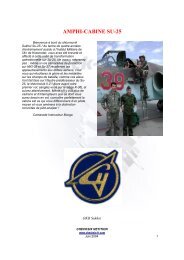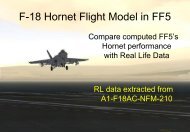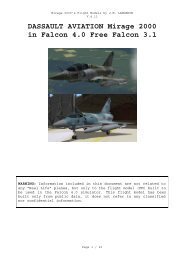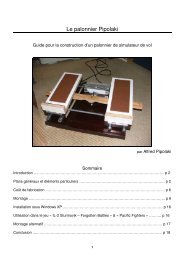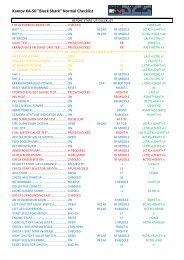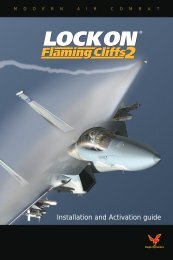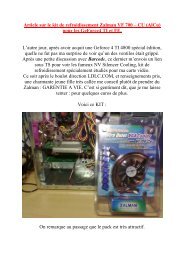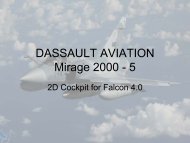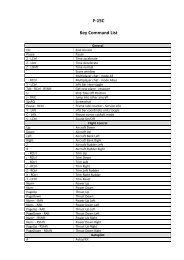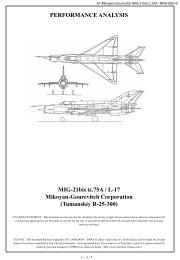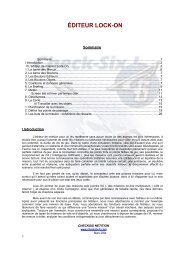You also want an ePaper? Increase the reach of your titles
YUMPU automatically turns print PDFs into web optimized ePapers that Google loves.
Cz limit = Stab<br />
efficiency<br />
AoA Max < 33<br />
Cz limit = Stall<br />
AoA_Stall > 33<br />
<strong>Mig</strong>-<strong>21</strong>-FM-Identification-Rev. 14<br />
I’ve chose to follow the values extracted from the fig.8 related to “big arm” curve to build the Cz laws<br />
of the flight model.<br />
There is no evidence that the α UUA is true incidence angle, or just incidence index as suggested in<br />
“MAKING THE BEST OF MiG-<strong>21</strong>” article, but in the rest of this document I do suppose the values<br />
are true incidence angle between the speed vector and the x plane axis (itself equal to the thrust vector)<br />
The analysis of the fig.8 also demonstrates that maximum available lift cannot be modeled by a unique<br />
incidence limit.<br />
We need here to distinguish two separates mach number ranges: under M0.95, maximum lift is<br />
reached for incidence values greater than 33 degrees, over M0.95 maximum lift is reached for<br />
incidence values lower than 33 degrees due to lack of pitch command efficiency.<br />
Comment : I do not have any evidence that the fig.8 value do or do not take into account the<br />
“swimming flap” device introduced in late <strong>Mig</strong>-<strong>21</strong>PFM, but this figures seems to be related to a MIG-<br />
<strong>21</strong>bis/iz.75 that does have it. This device, when activated, allows “automatic” flaps deployment and<br />
retract, between 0 and 25 degrees at low speed, the flaps angle is limited by dynamic pressure when<br />
speed increase, in a quite simple but pragmatic way. But this assumption seems reasonable when we<br />
see Cl value growing up to 1.3 for low mach. (We are not speaking here of the “landing” flaps system,<br />
that use air flow extracted from engine to blow flaps, identified as SPS system).<br />
Even if I’ve no figure describing <strong>Mig</strong>-<strong>21</strong> supersonic lift curve, I keep for mach number over 1.0, a<br />
C z (AoA,Mach) law defined between 0 and 33 degrees with a maximum at 33 and a linear portion<br />
between 0 and 15 degrees.<br />
For mach number under 0.9, I have built law on the basis of the values read from the figure for<br />
AoA=28 and AoA=33, and a maximum C z value, but for an unknown incidence.<br />
This table gives a possible set of values satisfying these<br />
criteria and the figure bellow displays graphically C z main<br />
values extracted from the L-17 manual (big arm curve):<br />
1.4000<br />
1.2000<br />
1.0000<br />
0.8000<br />
0.6000<br />
0.4000<br />
0.2000<br />
0.0000<br />
Max CL (Mach)<br />
0.00 0.50 1.00 1.50 2.00 2.50<br />
Figure 9<br />
Then we can go to the second step: identification of the incidence limitation along Mach number.<br />
In first approximation the (Ng,Mach) reachable domain is limited by<br />
Cz Max<br />
Cz(AoA=33)<br />
Cz(AoA=28)<br />
Mach Max Cz<br />
AoA for<br />
CzMax<br />
0.2 1.302 57.00<br />
0.3 1.207 57.00<br />
0.4 1.093 52.00<br />
0.5 1.018 47.00<br />
0.6 0.964 44.00<br />
0.7 0.931 39.00<br />
0.8 0.911 38.00<br />
0.9 0.899 35.00<br />
1.0 0.894 33.00<br />
1.1 0.841 31.14<br />
1.2 0.650 <strong>21</strong>.96<br />
1.3 0.524 17.66<br />
1.4 0.440 14.86<br />
1.5 0.393 13.43<br />
1.6 0.365 12.62<br />
1.7 0.352 12.17<br />
1.8 0.344 11.90<br />
Page - 12



